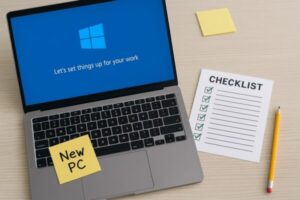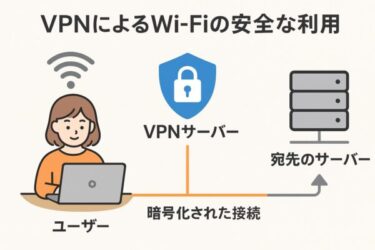Receiving a brand-new PC is exciting! But if you start using it right away, you might later think, “I should have set this up…” This article walks you through the essential initial settings and preparations you should make immediately after buying a Windows PC — in order.

- 1 Basic Settings & Handy Preparations
- 1.1 1. Initial Setup (Create or Log in to a Microsoft Account)
- 1.2 2. Connect to Wi‑Fi
- 1.3 3. Run Windows Update
- 1.4 4. Verify or Install Antivirus Software
- 1.5 5. Remove Unnecessary Pre‑installed Apps
- 1.6 6. Set Up Data Backup (OneDrive or External Drive)
- 1.7 7. Review Power Options & Sleep Settings
- 1.8 Recommended Settings
- 1.9 8. Install Browsers and Everyday Software
- 1.10 9. Customize Your Desktop & Shortcuts
- 1.11 10. Create a USB Recovery Drive
- 2 Summary: A Little Setup Goes a Long Way
Basic Settings & Handy Preparations
1. Initial Setup (Create or Log in to a Microsoft Account)
When you power on the PC for the first time, you’ll see the Windows initial setup screen.
Follow the on-screen instructions to sign in with or create a Microsoft account.
Why this matters
- Using a Microsoft account lets you seamlessly integrate OneDrive and Office.
- If you prefer, you can use an offline account, but beginners will find the online account more convenient.
2. Connect to Wi‑Fi
Connecting to the internet lets you download Windows updates and apps smoothly.
Select your home Wi‑Fi network and enter the password to connect.
3. Run Windows Update
A brand-new PC’s Windows installation is often not up to date.
※ Updates may take some time, so it’s best to do this early on.
How to update on Windows 11 / 10
1. Click the Start button (bottom-left)
2. Select the gear icon or go to “Settings”
(Shortcut: Press Windows key + I to open Settings directly)
3. Go to Settings → “Windows Update”
Check for and install available updates.
4. Verify or Install Antivirus Software
Windows includes built-in security (Windows Security / Defender).
▶︎ Learn more about Defender vs Firewall
If you’d rather, you can install a commercial antivirus product for added peace of mind.
⚠️ Note:
Using multiple security programs simultaneously can cause slowdowns or system issues.
5. Remove Unnecessary Pre‑installed Apps
New PCs often come with unwanted pre-installed software.
Go to Settings → Apps → Installed Apps to remove what you don’t need.
6. Set Up Data Backup (OneDrive or External Drive)
Protect your data from unexpected problems by setting up automatic backups.
Recommended Options
- OneDrive: Automatically back up your Desktop and Documents to the cloud.
- External HDD: Offline backup for those who prefer local storage.
7. Review Power Options & Sleep Settings
Configure when the screen turns off and how the PC conserves battery when not in use.
Steps:
- Click Start (bottom-left)
- Select the gear icon (“Settings”)
- Navigate to Settings → System → Power & battery → Advanced settings
- Click “Additional power settings” (Windows 11: “Additional power mode settings”) for more detailed control
Recommended Settings
| Status | Recommended Setting |
|---|---|
| Screen off (plugged in) | After 10–15 minutes |
| Time to sleep | On battery: 10 min / Plugged in: 30 min |
| Power mode | “Best performance” or “Balanced” |
If you never want your PC to sleep automatically, set the “sleep after” option to “Never”.
If you want the laptop to stay on when you close the lid:
- Go to “Additional power settings”
- Select “Choose what closing the lid does”
- Select “Do nothing” for lid closing
These detailed settings help prevent interruptions and extend battery life.
8. Install Browsers and Everyday Software
Install your commonly used apps all at once for a smoother start. For example:
- Google Chrome / Firefox (web browsers)
- LINE / Zoom / Teams (communication)
- Office apps like Word and Excel
9. Customize Your Desktop & Shortcuts
- Show icons like Recycle Bin, This PC, Downloads on the desktop
- Pin your frequently used apps to the taskbar
- Enable dark mode or change your wallpaper to your preference
▪ Wallpaper Settings (Windows 11/10)
- Right‑click on the desktop
- Select “Personalize”
- Choose “Background” or “Wallpaper”
- Select your style: Image, Slideshow, or Solid color
- Click “Browse” to select your preferred image and apply it
- Go with multiple images to set up a slideshow background.
- You can also download free wallpaper themes from the Microsoft Store.
10. Create a USB Recovery Drive
Creating a recovery USB drive now will be a lifesaver if your system ever encounters issues.
How to Create It
Type “Recovery Drive” in the search box → follow the on‑screen instructions to save it to a USB stick.
Summary: A Little Setup Goes a Long Way
That initial bit of setup effort makes a big difference in how smooth and secure your experience will be.
Resist the urge to “just start using it now,” and work through the 10 steps in order for a worry-free start.
Frequently Asked Questions (FAQ)
Q. Is a Microsoft account absolutely necessary?
You can use an offline account, but to access Microsoft Store and OneDrive, a Microsoft account is essential.
Q. Is free antivirus software okay?
Windows Defender is quite strong, but if you worry about protection, consider a paid solution.
Q. How much time does initial setup take?
Including Windows Update, allocate about 1–2 hours for a smooth start.
Setting up a new PC may seem daunting, but if you follow the steps one at a time, it’s completely manageable.
By following the tips in this guide, you can begin your PC journey with confidence and peace of mind.
To avoid future regrets of “I should have set that up…” make sure to check off everything now.
Recommended Articles:
▶︎ How to Fix Windows Update Error KB5063060 – Complete Guide
▶︎ How to Fix “No Internet Access” on Windows: Causes and Solutions
▶︎Why Windows Gets Stuck at 100% Disk Usage — Full Fix Guide for Automatic Maintenance Problems


